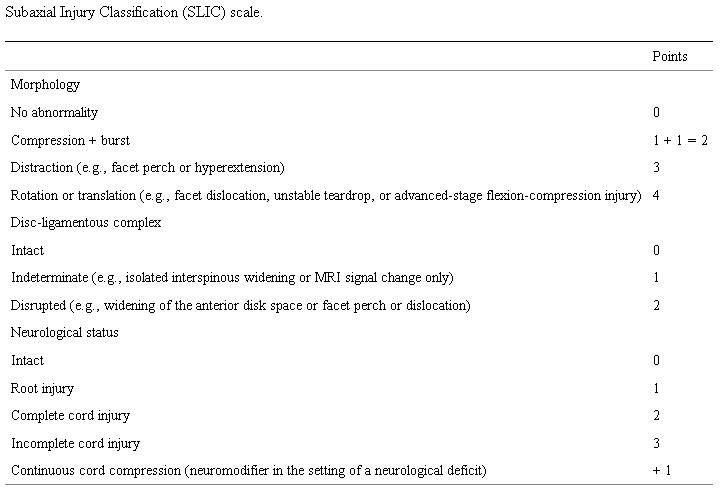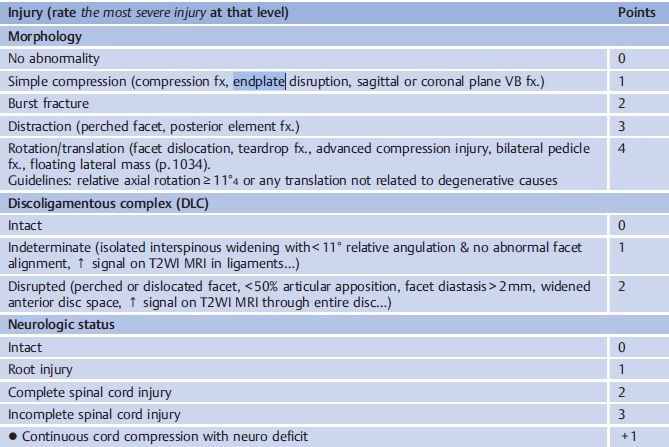Subaxial Injury Classification and Severity Scale
https://www.mdcalc.com/calc/10085/subaxial-injury-classification-severity-scale-slics
The Subaxial Cervical Spine Injury Classification System (SLICS) is a commonly used algorithm for diagnosing and managing subaxial cervical spine trauma. A SLIC score 4 suggests either surgery or non-surgically treatment depending on the surgeon's experience and patient's conditions.
Objective: Prognosis and treatment results were analyzed in patients with SLIC score 4.
Methods: The patients with SLIC score 4 were retrospectively reviewed from 2012 to 2019. Forty-one patients were included and divided into two groups: non-surgically treated and surgically treated. Demographic data and radiographs were analyzed. Statistical analysis was performed to determine the difference between the two clinical groups.
Results: Twenty-two patients were non-surgically treated, and nineteen patients were surgically treated. There was no neurological deterioration in both groups. However, there was no statistically significant difference in the last follow-up AISA and Nurick grade (p> 0.05). There was no significant difference in the number of patients who showed improvement when comparing the initial and the last follow-up neurological status (p> 0.05).
Conclusion: Regardless of the treatment method, the spinal cord injury patients with SLICS point 4 showed a relatively good prognosis. Patients with SLIC score 4 could be treated non-surgically or surgically based on the surgeon's experience and factors associated with the patient's acute health status and chronic comorbidities 1)
The Subaxial Injury Classification (SLIC) is a system that aids in injury classification and helps guide the decision-making process of conservative versus surgical treatment. Though promising, the SLIC system requires further validation.
To create the scale, a systematic review of the surgical treatment of subaxial cervical spine trauma was conducted, and a treatment algorithm was created with the evidence-based consensus of a group of specialists.
This classification of lower cervical spine injuries takes into account the following characteristics:
Morphology.
Status of the disco-ligamentous complex.
Neurological assessment.
Based on these parameters, a table is used to assign scores to each injury: individuals with a score lower than 4 do not require surgical intervention; a score of 4 means the treatment could be either surgical or conservative (often, the decision is made based on the personal experience of the surgeon); and a score higher than 4 normally means that surgical intervention is required
General information
The subaxial injury classification (SLIC) 2) assesses injuries to the disco-ligamentous complex (DLC) in addition to neurologic and bony injuries.
Inter-rater reliability intraclass correlation coefficient is 0.71.
▶ DLC integrity . The DLC includes: anterior longitudinal ligament (the strongest component of the anterior DLC), posterior longitudinal ligament, ligamentum flavum, facet capsule (the strongest component of the posterior DLC), interspinous and supraspinous ligaments. The DLC is the hardest SLIC parameter to evaluate. Largely inferred indirectly from MRI findings. Healing is less predictable than bone healing in the adult. More data needs to be accrued before this parameter can be reliably quantified.
SLIC score 4
A SLIC score 4 suggests either surgery or non-surgically treatment depending on the surgeon's experience and patient's conditions.
Objective: Prognosis and treatment results were analyzed in patients with SLIC score 4.
Methods: The patients with SLIC score 4 were retrospectively reviewed from 2012 to 2019. Forty-one patients were included and divided into two groups: non-surgically treated and surgically treated. Demographic data and radiographs were analyzed. Statistical analysis was performed to determine the difference between the two clinical groups.
Results: Twenty-two patients were non-surgically treated, and nineteen patients were surgically treated. There was no neurological deterioration in both groups. However, there was no statistically significant difference in the last follow-up AISA and Nurick grade (p> 0.05). There was no significant difference in the number of patients who showed improvement when comparing the initial and the last follow-up neurological status (p> 0.05).
Regardless of the treatment method, the spinal cord injury patients with SLICS point 4 showed a relatively good prognosis. Patients with SLIC score 4 could be treated non-surgically or surgically based on the surgeon's experience and factors associated with the patient's acute health status and chronic comorbidities 3).

